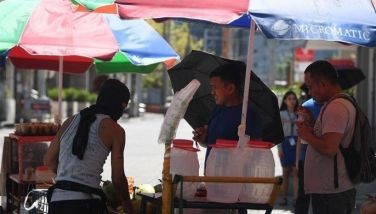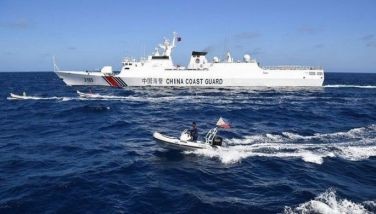YEARENDER: DENR intensifies campaign to save wildlife species
MANILA, Philippines - The year 2013 saw the Department of Environment and Natural Resources (DENR)’s ramp up efforts to save the country’s wildlife species and protected areas.
Among the incidents that made headlines last year was the death of Lolong, the world’s largest crocodile in captivity. The reptile died on Feb. 10 due to late-stage pneumonia and cardiac failure.
Protected Areas and Wildlife Bureau (PAWB) director Theresa Mundita Lim said fungus infected Lolong’s lungs and stress aggravated the problem after the reptile was captured in Agusan Marsh in 2011.
“Findings indicate that there could have been a chronic infection that may have been aggravated by stress,†Lim said.
“Even before Lolong’s capture, it was already not feeling well, and taking the crocodile from its natural habitat to a new home made its condition worse,†she added.
It was in 2012 when the Guinness World Records proclaimed Lolong, which measured 20.24 feet long and weighed 1,075 kilograms, as the largest saltwater crocodile in captivity.
The reptile was subjected to necropsy at the University of the Philippines Los Baños College of Veterinary Medicine.
Lim noted that Lolong’s death could lead to a better understanding of the condition of crocodiles in the wild and how to better manage them in captivity.
A study could also help determine the state of the Agusan Marsh to possibly improve its condition for the benefit of the wildlife in it and the communities that depend on its resources.
Environment Secretary Ramon Paje said “Lolong’s death would serve as an important reference as we review management and husbandry practices and ensure that we provide the appropriate environment for all animals in captivity.â€
“Just like humans, animals have certain physiological and environmental needs that should be met so that they would be capable of adapting well to different types of stress brought about by any change in environment,†Paje added.
Smuggled elephant tusks
Four months after Lolong’s death, the DENR was faced with the task of destroying at least five tons of smuggled elephant tusks using a road roller inside the PAWB compound in Quezon City.
Paje said the move was a reaffirmation of the country’s commitment to the Convention on International Trade in Endangered Species of Wild Flora and Fauna (CITES), an international treaty promulgated in 1973 to regulate commercial trade in certain wildlife species, including the critically endangered elephants.
“Despite the high price of raw ivory in the black market, the government had no choice but to destroy them as a strong indignation for the killing of hundreds of elephants by poachers who were after their precious tusks,†Paje said.
Lim said 60 kilos of the ivory tusks would be used for education purposes.
The DENR also organized the Philippine Operations Group on Ivory (POGI) to ensure that ivory smuggling into the country is properly investigated.
Apart from the DENR, members of POGI include the National Bureau of Investigation, Bureau of Customs, National Intelligence Coordinating Agency, Philippine National Police-National Capital Region Police Office, and the Criminal Investigation Detection Group.
Dead wildlifeconfiscated in Tondo
The DENR also issued a stern warning against poachers of wildlife species, following the confiscation by authorities of a large number of dead wildlife species during a raid in a house in Tondo, Manila in July.
The raiding team, headed by DENR Undersecretary and POGI head Ernesto Adobo Jr., recovered 78 Palawan hill mynas, 12 blue-naped parrots and five juvenile Indo-Pacific saltwater crocodiles, all dead.
Only 14 Philippine forest and pond turtles were retrieved alive.
Criminal charges were filed against the suspected owners and their possible cohorts.
“What’s particularly alarming about this poaching incident is that there were reports that most of these endangered animals were intentionally killed to avoid detection by authorities and such act carries a higher penalty,†Paje said.
Under Republic Act No. 9147 or the Wildlife Resources Conservation and Protection Act, illegal trade of endangered species is penalized by a fine of P200,000 and a jail term of two years, while the killing of endangered animals carries the penalty of imprisonment of six years and a fine of P500,000.
Natural parks awarded
Meanwhile, to showcase success stories in protected area management, the DENR awarded seven natural parks last October.
The Mt. Kitanglad Range Natural Park in Bukidnon; Taal Volcano Protected Landscape, which straddles 13 towns and three cities across the provinces of Batangas and Cavite in Southern Luzon; Apo Island Protected Landscape/Seascape off Dumaguete City in Negros Oriental; Northern Luzon’s Mt. Pulag National Park; Mts. Banahaw-San Cristobal Protected Landscape in Laguna and Quezon provinces; Mt. Mantalingahan Protected Landscape in Palawan, and the Tubbataha Reefs Natural Park also in Palawan were given recognition.
Paje said the awards were presented to protected area managers and staff for their “impressive efforts, initiatives and innovative practices†in the management of protected areas.
The move will provide incentives for the people managing protected areas.
“This way, we raise the bar on effective management practices, heighten awareness on the value of our protected areas and therefore advocate for their support from other sectors,†he added.
Likewise, the Mount Makiling Forest Reserve in Los Baños, Laguna has been declared as the 33rd Association of Southeast Asian Nations (ASEAN) Heritage Park.
This developed after environment ministers from the 10 member-states of the regional group approved the nomination of Makiling as a natural park during the 14th Informal ASEAN Ministerial Meeting on the Environment held last September in Indonesia.
Paje said Makiling was recognized for its high conservation importance and being named one of the country’s 18 centers of plant diversity and 32 key ecotourism sites.
“With its hot springs, gardens and scenery, it has been a prime ecotourism destination, given its proximity to Metro Manila. So the wonder is that, for all its wear and tear, the Mount Makiling Forest Reserve continues to thrive as a habitat for biodiversity, well enough to qualify as an ASEAN Heritage Park,†Paje said.
The Mount Makiling Forest Reserve joins four other ASEAN Heritage Parks in the Philippines: the Mt. Apo Natural Park, Mts. Iglit-Baco National Park, Mt. Kitanglad Range Natural Park, and Mt. Malindang Range Natural Park.
Philippine eagle dies
Members of the Davao-based Philippine Eagle Foundation (PEF) found a dead male Philippine Eagle on Mount Lumot in Gingoog City, Misamis Oriental last Oct. 11.
The DENR said the eagle’s death came barely two months after it was released back into the wild following a two-year rehabilitation.
PAWB said the eagle was identified as Minalwang, which the PEF released into Mount Balatukan Range Natural Park in Gingoog City last Aug. 15.
The PEF had been alerted after the satellite transmitter attached to the eagle to track its movements had stopped sending feedback.
“This is another blow for us, especially for our conservation program where we have been trying so hard to perpetuate the existence of our Haring Ibon,†Lim said.
The majestic Philippine Eagle is considered a critically endangered species by the International Union for the Conservation of Nature.
There are about 500 pairs of Philippine Eagles in the wild, and less than 50 – including those that have been bred in captivity or are being rehabilitated – are in the custody of the PEF and the DENR.
The Philippine Eagles and other wildlife are protected under Republic Act No. 9147 or the Wildlife Resources Conservation and Protection Act.
Under this law, a person who kills a wildlife species can be imprisoned from six to 12 years and fined from P100,000 to P1 million.
Lim said investigation is still ongoing though an initial report said infection could have been the cause of the eagle’s death.
Rebuilding typhoon-ravaged environment
The DENR also bared its plan to help in rebuilding Eastern Visayas, which was ravaged by Super Typhoon Yolanda in November.
The plan involves restoration of mangrove and beach forests along 380 kilometers of coastline in Eastern Visayas, including Leyte and all other portions damaged by Yolanda.
The move is expected to protect communities against the devastating effects of future storms.
A massive tree-planting activity under the government’s National Greening Program may take place in coastal areas in Tacloban City and Dulag town in Leyte; municipalities of Guiuan, Llorente and Balangiga in Eastern Samar; and the town of Basey in Samar to provide livelihood to residents and allow them to take part in building a “green wall†against storm surges.
The DENR and its Mines and Geosciences Bureau also inspected the affected areas.
The DENR said it would have to enforce a “no-build zone†with a 40-meter easement in coastal communities in the entire seaboard of Eastern Visayas affected by the super typhoon.
Paje stressed the tragedy caused by Yolanda underscores the need to revive the region’s degraded coastal forests to make its coastlines less vulnerable to extreme weather events.
- Latest
- Trending






























